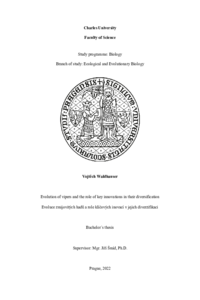Evolution of vipers and the role of key innovations in their diversification
Evoluce zmijovitých hadů a role klíčových inovací v jejich diverzifikaci
bakalářská práce (OBHÁJENO)

Zobrazit/
Trvalý odkaz
http://hdl.handle.net/20.500.11956/173156Identifikátory
SIS: 234984
Kolekce
- Kvalifikační práce [21483]
Autor
Vedoucí práce
Oponent práce
Gvoždík, Václav
Fakulta / součást
Přírodovědecká fakulta
Obor
Ekologická a evoluční biologie
Katedra / ústav / klinika
Katedra zoologie
Datum obhajoby
31. 5. 2022
Nakladatel
Univerzita Karlova, Přírodovědecká fakultaJazyk
Angličtina
Známka
Výborně
Klíčová slova (česky)
Viperidae, hadi, diverzifikační dynamika, klíčové inovace, fylogeneze, evoluční radiace,biogeografieKlíčová slova (anglicky)
Viperidae, snakes, diversification dynamics, key innovations, phylogeny, evolutionaryradiation, biogeographyČeleď zmijovitých se skládá z 36 rodů, které společně obsahují přes 350 druhů. Vyskytuje napříč Afrikou a většinou Eurasie, největší druhovou diverzitu ovšem najdeme v Severní a Jižní Americe, kde se vyskytuje přes 40 % všech druhů zmijí. Tato čeleď tedy chybí pouze v Austrálii, na Nové Guineji, Novém Zélandu, Madagaskaru a několika dalších ostrovech a souostrovích. Pochopitelně je také zpravidla nenalezneme ani v polárních oblastech. Výjimkou je zmije obecná (Vipera berus), která se jako jediný had vydala i za polární kruh. Relativní evoluční úspěch zmijí se přisuzuje množství "klíčových inovací", mezi které se řadí třeba solenoglyfní dentice, živorodost, přítomná v mnoha liniích, či termorecepční orgány u zástupců podčeledi Crotalinae. Zmijovití ovšem nejsou zajímaví jen pro svou evoluční historii, jsou také předmětem důležitých medicinálních studií zabývajících se jejich jedy a toxicitou. WHO totiž předpokládá, že více než 100 000 lidí zemře ročně v důsledku uštknutí hady a zmije mají na tomto čísle nezanedbatelný podíl. Tato bakalářská práce představuje shrnutí našeho poznání o evoluční historii této čeledi, včetně fylogeneze a biogeografie, a přemítá o mechanismech zodpovědných za její úžasnou diverzitu.
The family Viperidae consists of 36 genera, containing more than 350 species in total. The family is distributed throughout Africa and most of Eurasia, however the greatest diversity is located in North and South America, where more than 40 % of the viper species can be found. The family is thus missing only in Australia, New Guinea, Madagascar, New Zealand and a number of other islands and archipelagos. As with most reptiles, they are also almost completely absent from polar regions, with the exception of Vipera berus, the only snake that has ventured north of the Arctic Circle. Their relative evolutionary success is attributed to many so called "key innovations", which include solenoglyphous dentition, viviparity of many genera or heat- sensing pits in the subfamily Crotalinae. Vipers are not only interesting because of their evolutionary history, but they are also subject of important medical studies regarding their venom and toxicity. WHO estimates that around 100,000 people worldwide may die from snake bites each year. This thesis presents a summary of our current knowledge of the evolutionary history of this family, including phylogeny and biogeography, and contemplates the mechanisms behind its amazing diversity.
